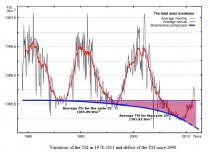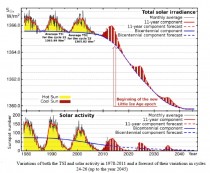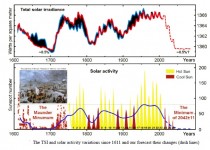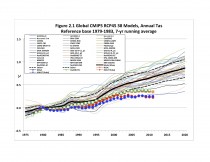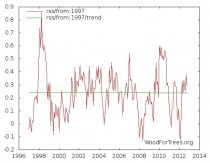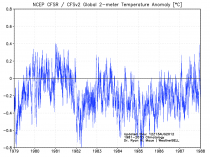By Joseph D’Aleo, CCM
Here are two extremes. The Russians looking for Maunder Minimum and the NCAR grant fed researchers an 8F warming based on model of satellite data. I await reaction of Drs. Spencer and Christy on the latter. (Update: John Christy has responded - see below the WAPO story).
Bicentennial Decrease of the Total Solar Irradiance Leads to Unbalanced Thermal Budget of the Earth
Habibullo I. Abdussamatov, Pulkovo Observatory of the RAS
Applied Physics Research Vol. 4, No. 1; February 2012
Abstract
Temporal changes in the power of the longwave radiation of the system Earth-atmosphere emitted to space always lag behind changes in the power of absorbed solar radiation due to slow change of its enthalpy. That is why the debit and credit parts of the average annual energy budget of the terrestrial globe with its air and water envelope are practically always in an unbalanced state.
Average annual balance of the thermal budget of the system Earth-atmosphere during long time period will reliably determine the course and value of both an energy excess accumulated by the Earth or the energy deficit in the thermal budget which, with account for data of the TSI forecast, can define and predict well in advance the direction and amplitude of the forthcoming climate changes.
From the early 1990s we observe bicentennial decrease in both the TSI and the portion of its energy absorbed by the Earth. The Earth as a planet will henceforward have negative balance in the energy budget which will result in the temperature drop in approximately 2014. Due to increase of albedo and decrease of the greenhouse gases atmospheric concentration the absorbed portion of solar energy and the influence of the greenhouse effect It will additionally decline.
The influence of the consecutive chain of feedback effects which can lead to additional drop of temperature will surpass the influence of the TSI decrease. The onset of the deep bicentennial minimum of TSI is expected in 2042 plus or minus 11, that of the 19th Little Ice Age in the past 7500 years - in 2055 plus or minus 11.
After the maximum of solar cycle 24, from approximately 2014 we can expect the start of the next bicentennial cycle of deep cooling with a Little Ice Age in 2055 plus or minus 11. Thus, long-term variations of TSI (with account for their direct and secondary, based on feedback effects, influence) are the main fundamental cause of climate changes since variations of the Earth climate is mainly determined by a long-term imbalance between the energy of solar radiation entering the upper layers of the Earth’s atmosphere and the total energy emitted from the Earth back to space.
See full paper PDF.
-------------------------------------
And the other polar opposite using models fed with satellite data by NCAR which by the way using models with proclaimed 97% accuracy predicted a record strong solar cycle for 24 with a max SSN of 169. The forecast was only100 off with the max at 66.9 so far and current 11 month means at 63.
Table from Solar Terrestial Activity Report
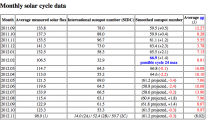
Enlarged
And remember the Layman’s Sunspot Count site which only counts spots larg enough to have been seen many decades ago so as to more acurately see trends.
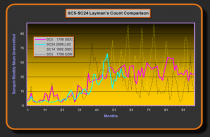
Enlarged
WARMER STILL: EXTREME CLIMATE PREDICTIONS APPEAR MOST ACCURATE, REPORT SAYS
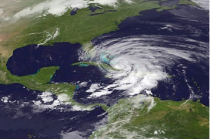
NOAA/REUTERS - Hurricane Sandy is seen churning northwards in this NOAA handout satellite image taken on October 25, 2012. According to climate scientists, the world could be in for a devastating increase of some eight degrees Fahrenheit by 2100, resulting in drastically higher seas, disappearing coastlines and more severe droughts, floods and other destructive weather.
Climate scientists agree the Earth will be hotter by the end of the century, but their simulations don’t agree on how much. Now a study suggests the gloomier predictions may be closer to the mark.
Warming is likely to be on the high side of the projections,” said John Fasullo of the National Center for Atmospheric Research in Boulder, Colo., a co-author of the report, which was based on satellite measurements of the atmosphere.
That means the world could be in for a devastating increase of about eight degrees Fahrenheit by 2100, resulting in drastically higher seas, disappearing coastlines and more severe droughts, floods and other destructive weather.
Such an increase would substantially overshoot what the world’s leaders have identified as the threshold for triggering catastrophic consequences. In 2009, heads of state agreed to try to limit warming to 3.6 degrees, and many countries want a tighter limit.
Climate scientists around the world use supercomputers to simulate the Earth’s atmosphere and oceans. Sophisticated programs attempt to predict how climate will change as society continues burning coal, oil and gas, the main sources of heat-trapping gases such as carbon dioxide. But these simulations spit out a wide range of warming estimates. All foresee an overheated planet in 2100, but some predict just three degrees of warming while others estimate eight or more degrees of extra heat.
“This problem has been around for 30 years,” Fasullo said. “As long as climate models have existed, there’s been this spread in projections of the future.”
One source of uncertainty involves the impact of cloud cover, especially clouds that form in the tropical and subtropical regions between about 30 degrees north and south of the equator. “Tropical clouds are so important to climate,” Fasullo said. “Small changes in clouds near the equator have a big effect on where you end up” for temperature predictions.
As sunlight pours onto the tropics, clouds bounce some of that heat back into space. Fewer clouds open up the atmosphere “like an iris,” Fasullo said, allowing more heat to beam onto Earth’s surface.
No supercomputer is powerful enough to predict cloud cover decades into the future, so Fasullo and colleague Kevin Trenberth struck on another method to test which of the many climate simulations most accurately predicted clouds: They looked at relative humidity. When humidity rises, clouds form; drier air produces fewer clouds. That makes humidity a good proxy for cloud cover.
Looking back at 10 years of atmospheric humidity data from NASA satellites, the pair examined two dozen of the world’s most sophisticated climate simulations. They found the simulations that most closely matched humidity measurements were also the ones that predicted the most extreme global warming.
In other words, by using real data, the scientists picked simulation winners and losers.
“The models at the higher end of temperature predictions uniformly did a better job,” Fasullo said. The simulations that fared worse ND the ones predicting smaller temperature rises “should be outright discounted,” he said.
The most accurate climate simulations were run by the United Kingdom’s Met Office, a consortium in Japan and a facility at the National Center for Atmospheric Research....
More.
------------------------------
REALITY CHECKS:
Note from Dr. John Christy
Joe:
Simple answer. When it comes to global temperature, the most sensitive models are the worst. Fasullo and Trenberth picked a rather obscure variable to hype, but when looking at the temperature itself, the worst models are the most sensitive models (attached, from my House testimony.)
John C.
The real trend in global tempErature from satellite (RSS) for the last 15 years is flat while these ‘skillful’ models predicted a steep rise.
As is the Hadley data (used by the IPCC).
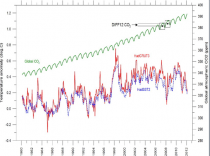
Enlarged
And the CFS unadjusted surface data since 1979 (Maue Weatherbell)
So why the constant push to manipulte data and hype natural disasters as proof that fossil fuels and man are responsible. Their own words tell us:
Maurice Strong, senior advisor to Kofi Annan, U.N. Secretary-General who chaired the gigantic (40,000 participants) “U.N. Conference on Environment and Development” in Rio de Janeiro in 1992 , who was responsible for putting together the Kyoto Protocol with thousands of bureaucrats, diplomats, and politicians, stated: “We may get to the point where the only way of saving the world will be for industrial civilization to collapse...isn’t it our job to bring that about”
“In searching for a new enemy to unite us, we came up with the idea that pollution, the threat of global warming, water shortages, famine and the like would fit the bill....All these dangers are caused by human intervention...and thus the “real enemy, then, is humanity itself....believe humanity requires a common motivation, namely a common adversary in order to realize world government. It does not matter if this common enemy is “a real one or...one invented for the purpose.” Quote by the Club of Rome.
Timothy Wirth, U.S. Undersecretary of State for Global Issues, seconded Strong’s statement: “We have got to ride the global warming issue. Even if the theory of global warming is wrong, we will be doing the right thing in terms of economic policy and environmental policy.”
“The data doesn’t matter. We’re not basing our recommendations on the data. We’re basing them on the climate models.” Prof. Chris Folland, Hadley Centre for Climate Prediction and Research
“The models are convenient fictions that provide something very useful.” Dr David Frame, Climate modeler, Oxford University
“It doesn’t matter what is true, it only matters what people believe is true.” - Paul Watson, Co-founder of Greenpeace”
“Unless we announce disasters no one will listen.” - Sir John Houghton, First chairman of the IPCC
“No matter if the science of global warming is all phony ... climate change provides the greatest opportunity to bring about justice and equality in the world.” - Christine Stewart, former Canadian Minister of the Environment
“The only way to get our society to truly change is to frighten people with the possibility of a catastrophe” - emeritus professor Daniel Botkin
”We are on the verge of a global transformation. All we need is the right major crisis.” - David Rockefeller, Club of Rome executive manager - Trustee of The Rockefeller Foundation a heavy funder of environmenal causes.
“This has almost nothing to do with environmental policy....one must say clearly that we redistribute de facto the world’s wealth by climate policy” - Ottmar Edehoffer, UN IPCC
----------------------
WARNINGS THIS WOULD HAPPEN
Eisenhower’s farewell address to the nation
“The free university, historically the fountainhead of free ideas and scientific discovery, has experienced a revolution in the conduct of research. Partly because of the huge costs involved, a government contract becomes virtually a substitute for intellectual curiosity. For every old blackboard there are now hundreds of new electronic computers.
The prospect of domination of the nation’s scholars by federal employment, project allocations, and the power of money is ever present - and is gravely to be regarded. Yet in holding scientific research and discovery in respect, as we should, we must also be alert to the equal and opposite danger that public policy could itself become the captive of a scientific-technological elite.”
---------
Vaclav Klaus, President of the Czech Republic, visited Australia in July 2011. In referring to the ideological orientations of those individuals and organisations who have significant financial and other vested interests in propagating the ‘Doctrine’ of anthropogenic induced climate change, President Klaus said: “They want to change us, to change our behaviour, our way of life, our values and preferences, they want to restrict our freedom because they themselves believe they know what is good for us. They are not interested in climate. They misuse the climate in their goal to restrict our freedom. What is endangered is freedom, the climate is okay.”
After noting that today’s human-induced climate change alarmists are the ideological descendents of the zero and negative population growth advocates of the 1970s who erroneously forecast that human population pressures would lead to increases in global poverty and growing shortages in resources, President Klaus went on to add: “They hate us, the humans, they consider us selfish and sinful creatures who must be controlled by them. I used to live in a similar world - called communism - and I know that it led to the worst environmental damage the world has ever experienced.”





